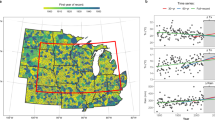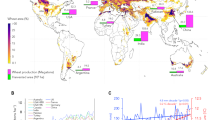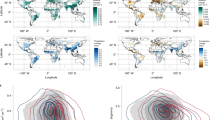Abstract
A critical question for agricultural production and food security is how water demand for staple crops will respond to climate and carbon dioxide (CO2) changes1, especially in light of the expected increases in extreme heat exposure2. To quantify the trade-offs between the effects of climate and CO2 on water demand, we use a ‘sink-strength’ model of demand3,4 which relies on the vapour-pressure deficit (VPD), incident radiation and the efficiencies of canopy-radiation use and canopy transpiration; the latter two are both dependent on CO2. This model is applied to a global data set of gridded monthly weather data over the cropping regions of maize, soybean, wheat and rice during the years 1948–2013. We find that this approach agrees well with Penman–Monteith potential evapotranspiration (PM) for the C3 crops of soybean, wheat and rice, where the competing CO2 effects largely cancel each other out, but that water demand in maize is significantly overstated by a demand measure that does not include CO2, such as the PM. We find the largest changes in wheat, for which water demand has increased since 1981 over 86% of the global cropping area and by 2.3–3.6 percentage points per decade in different regions.
This is a preview of subscription content, access via your institution
Access options
Access Nature and 54 other Nature Portfolio journals
Get Nature+, our best-value online-access subscription
$29.99 / 30 days
cancel any time
Subscribe to this journal
Receive 12 print issues and online access
$209.00 per year
only $17.42 per issue
Buy this article
- Purchase on Springer Link
- Instant access to full article PDF
Prices may be subject to local taxes which are calculated during checkout




Similar content being viewed by others
References
Leakey, A. D. B. et al. Elevated CO2 effects on plant carbon, nitrogen, and water relations: six important lessons from FACE. J. Exp. Bot. 60, 2859–2876 (2009).
Battisti, D. S. & Naylor, R. L. Historical warnings of future food insecurity with unprecedented seasonal heat. Science 323, 240–244 (2009).
Penman, H. L. Natural evaporation from open water, bare soil and grass. Proc. R. Soc. Lond. A 193, 120–145 (1948).
Sinclair, T. R., Wherley, B. G., Dukes, M. D. & Cathey, S. E. Penman’s sink-strength model as an improved approach to estimating plant canopy transpiration. Agric. For. Meteorol. 197, 136–141 (2014).
Miralles, D. G. et al. El Niño–La Niña cycle and recent trends in continental evaporation. Nat. Clim. Change 4, 122–126 (2014).
Mao, J. et al. Disentangling climatic and anthropogenic controls on global terrestrial evapotranspiration trends. Environ. Res. Lett. 10, 94008 (2015).
Sheffield, J., Wood, E. F. & Roderick, M. L. Little change in global drought over the past 60 years. Nature 491, 435–438 (2012).
Wada, Y., Wisser, D. & Bierkens, M. F. P. Global modeling of withdrawal, allocation and consumptive use of surface water and groundwater resources. Earth Syst. Dynam. 5, 15–40 (2014).
Zhang, Y. et al. Decadal trends in evaporation from global energy and water balances. J. Hydrometeorol. 13, 379–391 (2011).
Rosenzweig, C. et al. Assessing agricultural risks of climate change in the 21st century in a global gridded crop model intercomparison. Proc. Natl Acad. Sci. USA 111, 3268–3273 (2014).
Rötter, R. P., Veeneklaas, F. R. & van Diepen, C. A. in Studies in Environmental Science (eds Zwerver, S., Rompaey, R. S. A. R., Kok, M. T. J. & Berk, M. M.) Vol. 65, 947–950 (Elsevier, Amsterdam, 1995).
Greve, P. et al. Global assessment of trends in wetting and drying over land. Nat. Geosci. 7, 716–721 (2014).
Lobell, D. B. et al. The critical role of extreme heat for maize production in the United States. Nat. Clim. Change 3, 497–501 (2013).
Ray, J. D., Gesch, R. W., Sinclair, T. R. & Allen, L. H. The effect of vapor pressure deficit on maize transpiration response to a drying soil. Plant Soil 239, 113–121 (2002).
Sinclair, T. R., Tanner, C. B. & Bennett, J. M. Water-use efficiency in crop production. BioScience 34, 36–40 (1984).
Holzworth, D. P. et al. APSIM—evolution towards a new generation of agricultural systems simulation. Environ. Model. Softw. 62, 327–350 (2014).
Dietzel, R. et al. How efficiently do corn- and soybean-based cropping systems use water? A systems modeling analysis. Glob. Change Biol. 22, 666–681 (2016).
Nussbaumer, E. A. & Pinker, R. T. Estimating surface longwave radiative fluxes from satellites utilizing artificial neural networks. J. Geophys. Res. Atmos. 117, D07209 (2012).
Ma, Y. & Pinker, R. T. Modeling shortwave radiative fluxes from satellites. J. Geophys. Res. Atmos. 117, D23202 (2012).
Stackhouse, P. Jr et al. The NASA/GEWEX surface radiation budget release 3.0: 24.5-year dataset. GEWEX News 21, 10–12 (2011).
Harris, I., Jones, P. D., Osborn, T. J. & Lister, D. H. Updated high-resolution grids of monthly climatic observations—the CRU TS3.10 dataset. Int. J. Climatol. 34, 623–642 (2014).
Sheffield, J., Goteti, G. & Wood, E. F. Development of a 50-year high-resolution global dataset of meteorological forcings for land surface modeling. J. Clim. 19, 3088–3111 (2006).
Tanner, C. B. & Sinclair, T. R. in Limitations to Efficient Water Use in Crop Production (eds H. Taylor et al.) 1–28 (American Society of Agronomy, Madison, 1983).
Sinclair, T. R. & Rufty, T. W. Nitrogen and water resources commonly limit crop yield increases, not necessarily plant genetics. Glob. Food Secur. 1, 94–98 (2012).
Zwart, S. J., Bastiaanssen, W. G. M., de Fraiture, C. & Molden, D. J. A global benchmark map of water productivity for rainfed and irrigated wheat. Agric. Water Manag. 97, 1617–1627 (2010).
Zhang, X., Chen, S., Liu, M., Pei, D. & Sun, H. Improved water use efficiency associated with cultivars and agronomic management in the North China plain. Agron. J. 97, 783–790 (2005).
Mittler, R. Abiotic stress, the field environment and stress combination. Trends Plant Sci. 11, 15–19 (2006).
Urban, D. W., Sheffield, J. & Lobell, D. B. The impacts of future climate and carbon dioxide changes on the average and variability of US maize yields under two emission scenarios. Environ. Res. Lett. 10, 45003 (2015).
Vanuytrecht, E. & Thorburn, P. J. Responses to atmospheric CO2 concentrations in crop simulation models: a review of current simple and semicomplex representations and options for model development. Glob. Change Biol. 23, 1806–1820 (2017).
Sacks, W. J., Deryng, D., Foley, J. A. & Ramankutty, N. Crop planting dates: an analysis of global patterns. Glob. Ecol. Biogeogr. 19, 607–620 (2010).
Piccinni, G., Ko, J., Marek, T. & Howell, T. Determination of growth-stage-specific crop coefficients (KC) of maize and sorghum. Agric. Water Manag. 96, 1698–1704 (2009).
Hamilton, S. K., Hussain, M. Z., Bhardwaj, A. K., Basso, B. & Robertson, G. P. Comparative water use by maize, perennial crops, restored prairie, and poplar trees in the US Midwest. Environ. Res. Lett. 10, 64015 (2015).
McVicar, T. R. et al. Global review and synthesis of trends in observed terrestrial near-surface wind speeds: implications for evaporation. J. Hydrol. 416–417, 182–205 (2012).
Roderick, M. L., Hobbins, M. T. & Farquhar, G. D. Pan evaporation trends and the terrestrial water balance. II. Energy balance and interpretation. Geogr. Compass 3, 761–780 (2009).
Estes, L. D. et al. Changing water availability during the African maize-growing season, 1979–2010. Environ. Res. Lett. 9, 75005 (2014).
Hobbins, M. T., Dai, A., Roderick, M. L. & Farquhar, G. D. Revisiting the parameterization of potential evaporation as a driver of long-term water balance trends. Geophys. Res. Lett. 35, L12403 (2008).
Lobell, D. B. et al. The shifting influence of drought and heat stress for crops in Northeast Australia. Glob. Change Biol. 21, 4115–4127 (2015).
Asseng, S. et al. Performance of the APSIM-wheat model in Western Australia. Field Crops Res. 57, 163–179 (1998).
Archontoulis, S. V., Miguez, F. E. & Moore, K. J. Evaluating APSIM maize, soil water, soil nitrogen, manure, and soil temperature modules in the Midwestern United States. Agron. J. 106, 1025–1040 (2014).
Author information
Authors and Affiliations
Contributions
D.W.U. and D.B.L. conceived the study. D.W.U. performed all the analyses. J.S. contributed data and expertise on historical meteorological patterns. All the authors contributed to preparing the manuscript.
Corresponding author
Ethics declarations
Competing interests
The authors declare no competing financial interests.
Additional information
Publisher’s note: Springer Nature remains neutral with regard to jurisdictional claims in published maps and institutional affiliations.
Electronic supplementary material
Supplementary Information
Supplementary Figures 1–6
Rights and permissions
About this article
Cite this article
Urban, D.W., Sheffield, J. & Lobell, D.B. Historical effects of CO2 and climate trends on global crop water demand. Nature Clim Change 7, 901–905 (2017). https://doi.org/10.1038/s41558-017-0011-y
Received:
Accepted:
Published:
Issue Date:
DOI: https://doi.org/10.1038/s41558-017-0011-y
This article is cited by
-
Multifaceted characteristics of dryland aridity changes in a warming world
Nature Reviews Earth & Environment (2021)
-
The green and blue crop water requirement WATNEEDS model and its global gridded outputs
Scientific Data (2020)
-
Diverging importance of drought stress for maize and winter wheat in Europe
Nature Communications (2018)



